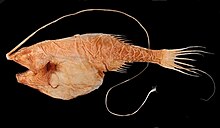Whipnose angler
| Whipnose Angler | |
|---|---|

| |
| A dried up specimen of a Whipnose. | |
| Scientific classification | |
| Domain: | Eukaryota |
| Kingdom: | Animalia |
| Phylum: | Chordata |
| Class: | Actinopterygii |
| Order: | Lophiiformes |
| Suborder: | Ceratioidei |
| Family: | Gigantactinidae Boulenger, 1904 |
| Genera | |
|
see text | |
The whipnose anglers are a family, the Gigantactinidae, of marine ray-finned fishes which is classified within the suborder Ceratioidei, the deep sea anglerfishes. These fishes are found in the Atlantic, Indian and Pacific Oceans.
Taxonomy
[edit]Whipnose anglers are classified within the family Gigantactinidae which was proposed as a monotypic family in 1904 by the Belgian-born British ichthyologist George Albert Boulenger for the genus Giganactis.[1] Giganactis was first proposed as a monospecific genus by the German zoologist August Brauer when he described Giganactis vanhoeffeni from the Indian Ocean east of Zanzibar on the German Deep Sea Expedition. In 1925 a second genus Rhynchactis was added by the English ichthyologist Charles Tate Regan.[2] The 5th edition of Fishes of the World classifies this family within the suborder Certioidei within the order Lophiiformes, the anglerishes.[3]
Genera
[edit]The whipnose angler family, Gigantactinidae, comprises the following two genera:[4]
- Gigantactis Brauer, 1902
- Rhynchactis Regan, 1925
Etymology
[edit]The whipnose angler family name, Gigantactinidae, has a name that is derived from Giganactis, its type genus and the only genus in the family when it was proposed by Boulenger. Gigantactis is a combination of gigantos, meaning "giant", with actis, which means "ray", an allusion to the unusually long illicium of genus's type species, G. vanhoeffeni.[5]
Characteristics
[edit]The whipnose anglers are deep sea anglerfishes with elongate bodies which differ from other Ceratioid families by the metamorphosed females having a very long illicium, the pectoral fins containing 5 radials and a long caudal peduncle.[2] The largest species in the family is G. vanhoeffeni with a maximum published total length of 62 cm (24 in).[6] Metamorphosed whipnose angler males have very small eyes and a large olfactory apparatus with the forward nostrils positioned close together opening to the front. The premaxilla is reduced and there are no teeth in the jaws. The denticular teeth are separate with between 3 and 6 on the upper denticular, rarelt 2, and between 4 and 7, rarely 3, on the lower denticular.[2]
Distribution and habitat
[edit]Whipnose anglers are found in the tropical and temperate parts of the Atlantic, Indian and Pacific Oceans in the bathypelagic and mesopelagic zones from depths between 0 and 5,300 m (0 and 17,388 ft).[7][8]
Biology
[edit]Whipnose angler males do not appear to be sexual parasites on the females, they appear to continue to grow after metamorphosis despite there being no evidence of feeding following metamorphosis.[2]
References
[edit]- ^ Richard van der Laan; William N. Eschmeyer & Ronald Fricke (2014). "Family-group names of recent fishes". Zootaxa. 3882 (2): 1–230. doi:10.11646/zootaxa.3882.1.1. PMID 25543675.
- ^ a b c d E. Bertelsen; Theodore W. Pietsch; and Robert J. Lavenberg (1981). "Ceratioid anglerfishes of the family Gigantactinidae: morphology, systematics, and distribution". Contributions in Science (Los Angeles). 332: 1–74.
- ^ Nelson, J.S.; Grande, T.C.; Wilson, M.V.H. (2016). Fishes of the World (5th ed.). Hoboken, NJ: John Wiley & Sons. pp. 508–518. doi:10.1002/9781119174844. ISBN 978-1-118-34233-6. LCCN 2015037522. OCLC 951899884. OL 25909650M.
- ^ Eschmeyer, William N.; Fricke, Ron & van der Laan, Richard (eds.). "Genera in the family Gigantactinidae". Catalog of Fishes. California Academy of Sciences. Retrieved 11 August 2024.
- ^ Christopher Scharpf (3 June 2024). "Order LOPHIIFORMES (part 2): Families CAULOPHRYNIDAE, NEOCERATIIDAE, MELANOCETIDAE, HIMANTOLOPHIDAE, DICERATIIDAE, ONEIRODIDAE, THAUMATICHTHYIDAE, CENTROPHRYNIDAE, CERATIIDAE, GIGANTACTINIDAE and LINOPHRYNIDAE". The ETYFish Project Fish Name Etymology Database. Christopher Scharpf. Retrieved 11 August 2024.
- ^ Froese, Rainer, and Daniel Pauly, eds. (2024). "Gigantactinidae" in FishBase. April 2024 version.
- ^ Froese, Rainer; Pauly, Daniel (eds.) (2024). "Giganactis vanhoeffeni" in FishBase. June 2024 version.
- ^ Froese, Rainer; Pauly, Daniel (eds.) (2024). "Rhynchactis microthrix" in FishBase. June 2024 version.
